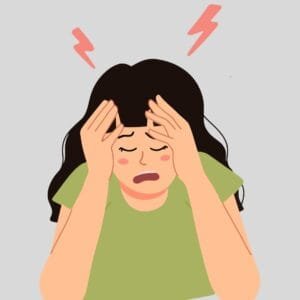Migraine: Causes, Symptoms, and Treatment
Migraine is a common neurological disorder characterized by intense, recurring headaches often accompanied by nausea, sensitivity to light and sound, and visual disturbances. It affects millions worldwide and can significantly impact daily life. While there is no cure, effective treatments and lifestyle adjustments can help manage symptoms and reduce the frequency of attacks.



What is a Migraine?
A migraine is more than just a headache. It is a complex condition involving changes in brain activity, blood flow, and nerve signaling. Migraines typically progress through four stages:
- Prodrome: Subtle warning signs such as mood changes, food cravings, or fatigue.
- Aura: Visual or sensory disturbances, such as flashing lights, blind spots, or tingling.
- Headache: Moderate to severe pain, often on one side of the head, lasting hours to days.
- Postdrome: A “migraine hangover” with fatigue, confusion, or difficulty concentrating after the headache subsides.
Not everyone experiences all stages during a migraine.
Types of Migraines
Migraines are classified into several types based on their symptoms and triggers:
- Migraine Without Aura: The most common type, featuring throbbing pain without sensory disturbances.
- Migraine With Aura: Includes visual, sensory, or speech disturbances before the headache begins.
- Chronic Migraine: Occurs 15 or more days a month, often associated with medication overuse.
- Hemiplegic Migraine: Rare migraines causing temporary weakness or paralysis on one side of the body.
- Ocular (Retinal) Migraine: Involves temporary vision loss or visual disturbances in one eye.
Causes and Triggers of Migraines
The exact cause of migraines is unclear, but they are believed to result from abnormal brain activity affecting blood vessels and nerves. Common triggers include:
1. Hormonal Changes
- Fluctuations in estrogen during menstruation, pregnancy, or menopause.
2. Dietary Factors
- Trigger foods such as caffeine, alcohol, processed meats, and aged cheeses.
3. Stress and Emotional Factors
- Anxiety, depression, and stressful events.
4. Environmental Triggers
- Bright lights, loud noises, strong odors, or weather changes.
5. Sleep Patterns
- Lack of sleep, oversleeping, or irregular schedules.
6. Medications
- Overuse of pain relievers or certain hormonal therapies.
Symptoms of a Migraine
Migraine symptoms vary from person to person but commonly include:
- Headache: Throbbing or pulsing pain, often on one side of the head.
- Nausea and Vomiting: Frequently accompany migraine pain.
- Sensitivity: Heightened sensitivity to light, sound, and smells.
- Visual Disturbances (Aura): Flashes of light, blind spots, or zigzag patterns.
- Fatigue and Irritability: Before or after the headache phase.
Severe migraines can interfere with daily activities, making it essential to identify triggers and seek treatment.
Diagnosing Migraines
A migraine diagnosis is based on medical history, symptoms, and physical examination. Diagnostic steps include:
- Detailed History:
- Frequency, duration, and intensity of headaches.
- Presence of triggers or aura.
- Neurological Examination:
- Assess reflexes, coordination, and sensory response.
- Imaging Tests (if needed):
Keeping a headache diary helps in identifying patterns and triggers.
Treatment Options for Migraines
Migraine treatment aims to relieve symptoms and prevent future attacks. Options include:
Medications for Acute Relief
- Pain Relievers:
- Over-the-counter drugs like ibuprofen, aspirin, or acetaminophen.
- Triptans:
- Prescription medications (e.g., sumatriptan, rizatriptan) targeting serotonin pathways.
- Ergotamines:
- For severe attacks, though less commonly used today.
- Anti-Nausea Medications:
- To alleviate nausea and vomiting (e.g., metoclopramide).
Preventive Medications
- Beta-Blockers:
- Such as propranolol, reduce the frequency of migraines.
- Antidepressants:
- Amitriptyline and similar drugs help prevent migraines.
- Antiepileptics:
- Medications like topiramate stabilize nerve activity.
- CGRP Inhibitors:
- Newer drugs targeting calcitonin gene-related peptide pathways.
Therapies and Lifestyle Modifications
- Cognitive Behavioral Therapy (CBT):
- Helps manage stress and emotional triggers.
- Biofeedback:
- Monitors and trains physical responses to reduce migraine severity.
- Acupuncture:
- May help reduce migraine frequency in some individuals.
Managing Migraines at Home
Lifestyle changes can significantly reduce the frequency and severity of migraines:
- Identify Triggers:
- Maintain a headache diary to recognize and avoid triggers.
- Stick to a Routine:
- Regular sleep, meals, and exercise promote stability.
- Stay Hydrated:
- Dehydration can worsen headaches.
- Practice Relaxation Techniques:
- Meditation, yoga, or deep breathing to reduce stress.
- Avoid Overuse of Medications:
- Excessive use can lead to rebound headaches.
Complications of Migraines
If left untreated, migraines can lead to complications such as:
- Chronic Migraine:
- Frequent attacks reducing overall quality of life.
- Medication Overuse Headache:
- Caused by excessive use of pain relievers.
- Stroke:
- Rare but higher risk in migraine with aura.
- Emotional and Social Impact:
- Depression, anxiety, and missed work or social activities.
Preventing Migraines
Prevention strategies focus on reducing triggers and maintaining a healthy lifestyle:
- Maintain a Healthy Diet:
- Avoid trigger foods and eat regularly.
- Exercise Regularly:
- Aerobic activities help reduce stress and improve circulation.
- Get Enough Sleep:
- Aim for 7–8 hours of quality sleep each night.
- Manage Stress:
- Incorporate relaxation techniques into your routine.
- Consider Preventive Medications:
- For frequent migraines, consult a doctor about preventive options.
FAQs about Migraines
1. What causes migraines?
Migraines are caused by abnormal brain activity affecting blood flow, nerves, and chemicals. Triggers vary widely, including stress, hormonal changes, and certain foods.
2. How is a migraine different from a regular headache?
Migraines are more severe, often accompanied by nausea, sensitivity to light and sound, and sometimes aura symptoms.
3. Can migraines be cured?
There is no cure for migraines, but treatments and lifestyle changes can help manage symptoms effectively.
4. What foods should I avoid if I have migraines?
Common triggers include caffeine, alcohol, chocolate, aged cheeses, and processed meats.
5. When should I see a doctor for migraines?
Seek medical advice if you have frequent, severe, or worsening headaches that interfere with daily life.
Conclusion
Migraine is a debilitating condition, but with the right combination of treatments, lifestyle adjustments, and support, many people can effectively manage their symptoms. Early diagnosis and a proactive approach are essential for improving quality of life. If you or someone you know suffers from migraines, consult a healthcare provider for a tailored treatment plan.
